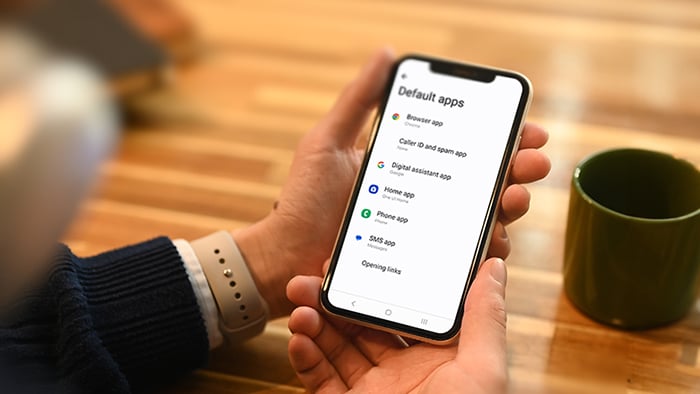Pop-ups can be overwhelming, but you can easily manage or block pop-ups completely. Follow the steps below to learn how to use your settings to manage pop-ups in a way that works best for you.
How to access the Firefox pop-up settings
If you’d like to manage the pop-up blocker feature in Firefox, the first step is to access the settings. Here’s how to access the pop-up settings in Firefox:
-
Open a new browser window in Firefox and click the hamburger menu (three stacked lines) in the upper-right corner.
/img_01.png?width=1212&name=img_01.png)
-
Choose Options from the drop-down menu.
/img_02.png?width=550&name=img_02.png)
-
Select Privacy & Security from the menu on the left-hand side.
/img_03.png?width=1635&name=img_03.png)
-
Scroll down to the Permissions section and find the setting Block pop-up windows.
/img_04.png?width=1732&name=img_04.png)
Now you can manage your pop-up settings. Firefox blocks pop-ups by default, so keep the box checked to continue blocking pop-ups in Firefox.
If you want to grant pop-up exceptions to individual websites (because you trust them or don’t want to miss any notifications or messages), click the Exceptions box and customize your list there. You can learn more about managing Firefox pop-up exceptions here.
For more details on blocking pop-ups in Firefox, skip down to our dedicated section. Otherwise, let’s learn how to allow Firefox pop-ups.
How to allow pop-ups on Firefox
Firefox knows that most pop-ups are unwanted — it has pop-up blocking automatically enabled, which means that Firefox blocks pop-ups by default.
If you’d like to disable this setting so that Firefox allows all pop-ups, here’s how:
-
Follow Steps 1 through 4 listed above to access the Permissions page and find the setting Block pop-up windows.
-
Then, uncheck the box to the left of the Block pop-up windows setting to disable the Firefox pop-up blocker and allow all pop-ups.
/img_05.png?width=1148&name=img_05.png)
How to allow pop-up exceptions on Firefox
Perhaps you’d like to allow pop-ups only for specific websites where they may be necessary? That’s possible too — here’s how:
-
Instead of un-checking the box next to Block pop-up windows, as described just above, leave the pop-up blocker enabled and click the Exceptions button to the right of this setting.
/img_06.png?width=1618&name=img_06.png)
-
A window will open with an option to add the address of a website. Type or paste the URL of any websites you’d still like to receive pop-ups on.
/img_07.png?width=1163&name=img_07.png)
-
Click Allow below the website URL. The website will appear in the field below with its pop-up status set to “Allow.”
-
Click Save Changes.
/img_08.png?width=1163&name=img_08.png)
Pop-ups should now be visible on any sites you’ve added under “Exceptions,” and they should be blocked on all other sites.
How to block pop-ups on Firefox
Maybe at some point you needed to allow pop-ups, but now the onslaught of ads, notifications, and new windows has become overwhelming and you’d like to enable the pop-up blocker on Firefox again. Here’s how to turn on Firefox’s pop-up blocker:
-
Access Firefox’s pop-up settings.
Use Steps 1 through 4 above to access and manage Firefox’s pop-up settings.
-
Check the box Block pop-up windows.
Once you check this box, your pop-ups will be blocked.
/img_09.png?width=1276&name=img_09.png)
Blocking all those self-opening windows makes for much cleaner and less frustrating browsing. Another way to create a smoother online experience is to delete all your browser cookies and clear your browser history, which can free up disk space for what you really need.
Although you can do all this manually, a browser cleaning tool will automatically clear your cookies and browser history for you, helping to speed up your computer.
Why am I still seeing pop-ups?
Although Firefox’s pop-up blocker is effective at keeping most pop-ups blocked, there are some pop-ups that it can’t control. Firefox can only block pop-ups that come from its own browser. If the pop-up is coming from a third-party source, Firefox can’t block it.
Though it’s unlikely that third-party pop-ups are hiding anything malicious, malware can be accidentally downloaded through deceptive browser extensions. So it’s important to remove unwanted extensions from Firefox — to make sure any associated pop-ups or even malware are also purged.
Another way pop-ups can evade Firefox’s default blocking setting is if they’re triggered by actions like mouse clicks or keystrokes (perhaps more likely for those who know various keyboard shortcuts for every browser). Firefox has intentionally included this loophole in pop-up settings, because websites sometimes need pop-ups to function correctly.
For example, when you click a delete button, you often need to confirm the action in a separate confirmation window. Unfortunately, this click-trigger can be abused by sneaky advertisers. Sometimes a pop-up ad contains a false “Close” or “Exit” button that simply triggers a new pop-up to open — signaling a potential adware infection and endless frustration!
Another reason you might still be seeing pop-up ads on Firefox is that they’re not true pop-ups. Some types of ads, like hover ads and in-page pop-ups, are designed to appear like new windows, but are technically still part of the original web page. These “pop-ups” cannot be removed with a pop-up blocker. You’ll need an ad blocker to stop ads like these in Firefox.
If you’d like to easily block ads and pop-ups, consider switching to a secure browser that includes robust ad blocking functionality by default. Avast Secure Browser blocks ads automatically, including hover ads and in-page pop-ups, for a much cleaner online experience.
What are Firefox pop-ups, exactly?
Firefox pop-ups are smaller browser windows, usually containing advertisements, that suddenly appear in front of the main browser page. This aggressive disruption, where an advertiser interrupts you with their own content, has been frustrating internet users for decades.
Pop-ups were first used in the late 1990s, because advertisers didn’t want their ads to be shown on webpages that included adult content.
But not all of these windows pop up. When an ad window appears beneath the active browser window, it’s called a pop-under. Although this strategy is less immediately disruptive, it’s also sneakier, because you see the pop-under only after closing all your browser windows. And it’s also harder to know where it came from.
Firefox’s pop-up blocker works on both pop-ups and pop-unders, because both appear as separate windows from the main browser page.
Should I enable pop-ups on Firefox?
Although pop-ups are mostly frustrating, they can also be functional — you may need to fill out a certain form that loads in a pop-up window. Confirmation windows in online banking sometimes appear as pop-ups, and help windows are often pop-ups as well.
If you frequently visit a site that uses functional pop-ups, you can add that website to the Exceptions list in Firefox’s settings so that those pop-ups remain enabled, while all others are blocked.
Firefox lets you enable pop-ups or keep them blocked, and other browsers do, too. You can learn how to allow and block pop-ups in Edge or Internet Explorer, or how to manage pop-ups in Chrome. If you’re a Mac user, you’ll want to learn how to allow and block pop-ups in Safari.
Beyond the annoying nature of pop-up ads, the content can be unappealing as well. If you’re not using Firefox’s private browsing mode, you’re collecting cookies on every site, and all your searches are being stored. Cookies are used to track your behavior and collect data for advertisers so that they can customize their ads to your perceived interests.
A pop-up with a random ad is annoying, but a pop-up with an ad based on your browsing data is annoying and invasive. You can use private browsing or incognito mode to clear your cookies, history, and searches from your private session after you’re finished browsing. Or learn how to disable and enable cookies. Just note that private browsing wipes that data only locally on your device.
To strengthen your privacy further, use anonymous browsing, which helps keep your data private and secure. Of course, some browsers are better at protecting privacy than others.
Take control of your browsing experience with Avast Secure Browser
The internet is a diverse place, and you can customize how you experience it. With tools like Avast Secure Browser, you don’t have to suffer through recurring pop-up ads or worry about your information being tracked from site to site.
Avast Secure Browser was built by dedicated security and privacy experts, and it lets you easily enable or disable pop-ups and automatically blocks ads and tracking. It even offers special features like the ability to control which websites can access your webcam and anti-phishing features that block dangerous websites and downloads.
As you spend more and more time online, the experiences you have there matter more. That’s why it’s so important to use a streamlined browser you can trust.
/Academy-How-to-allow-and-block-pop-ups-in-Firefox-Hero.jpg?width=1200&name=Academy-How-to-allow-and-block-pop-ups-in-Firefox-Hero.jpg)
/img_01.png?width=1212&name=img_01.png)
/img_02.png?width=550&name=img_02.png)
/img_03.png?width=1635&name=img_03.png)
/img_04.png?width=1732&name=img_04.png)
/img_05.png?width=1148&name=img_05.png)
/img_06.png?width=1618&name=img_06.png)
/img_07.png?width=1163&name=img_07.png)
/img_08.png?width=1163&name=img_08.png)
/img_09.png?width=1276&name=img_09.png)











